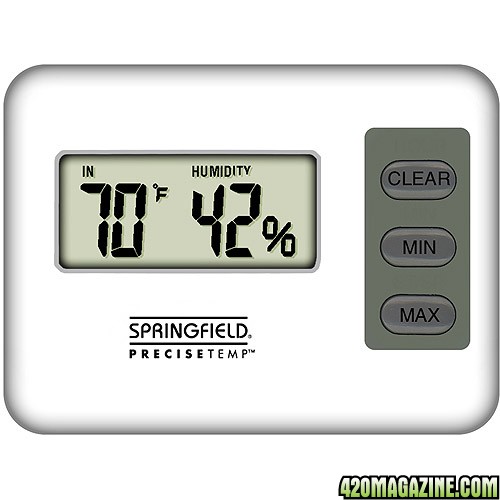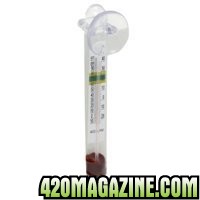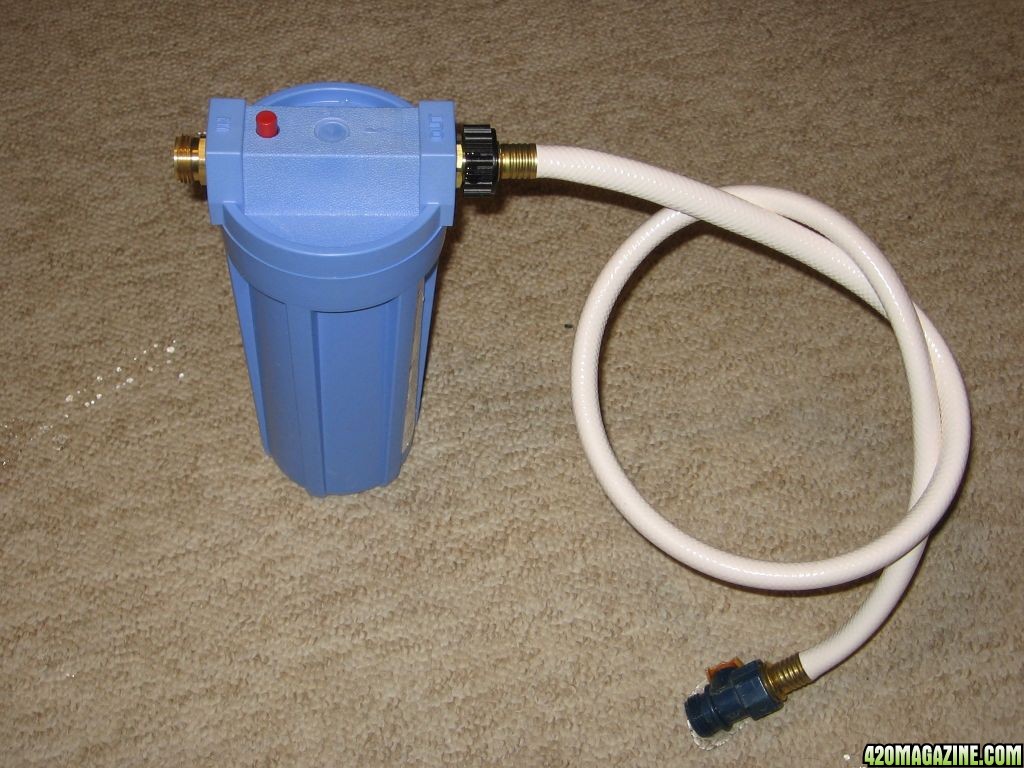Temperatures, Humidity
The temperature is the hardest factor to take control of to me. When confined to a small space, ballasts and HID lights can push temperatures sky-high in no time flat. That is why I use CFLS, to avoid venting heat. This is especially true during hot summer months when outside temperatures reach the highest temps. Nighttime (LIGHTS OFF period) temperature can be just as difficult to regulate during cold winter months. Most gardeners are aware that temperature in the grow room plays a major role and can greatly affect the growth of plants and the quality of the finished crop. Most gardeners do not know how controlling the temperature of their garden in very specific ways can achieve a superior crop. Drift too far from these ideal temperatures and watch your plants and crop suffer.
Before getting started it is highly recommended that every indoor garden has a Max/Min thermometer. (Digital $4.95 at Walmart)

This product allows the gardener to see exactly the fluctuations in temperature within their garden, day and night. Without this useful tool there is no accurate way of knowing the different temperatures between daytime (lights on) and nighttime (lights off). The difference between the two temperatures is very important to plant growth. Anymore than a 10F-15F difference between daytime and nighttime temperatures and you risk shocking and stressing the plants. You want a 10 degree difference between LIGHTS ON and LIGHTS OFF temps. In general the optimal daytime temperature for plant growth is between 70F -75F. Drift to far above this range or too far below and growth can be severely affected. Daytime temperatures exceeding 90F or under 62F and plant growth will be slowed and stunted. Plants do thrive in Afganastan's 110 degrees, but they momentarily quit growing at that temp. If the temperature drifts higher than 95F the plant’s enzyme production will drop off and the plant will begin shutting down. At temperatures above 92 - 94, high photosynthesis shuts down due to the stomata in the leaves closing down to conserve water. At normal temperatures the stomata will be open, taking in CO2 and sweating water to keep the plant cool and allowing for transpiration.
Ideal temperature varies depending on whether or not CO2 is being introduced to the environment. A more suitable daytime temperature when the air is being enriched with CO2 is 80F-85F. This temperature range promotes the exchange of gases between the plants and the environment. Also, it can speed up the process of photosynthesis. Plants in an environment at 86F can perform carbon extraction from CO2 twice as fast as at 68F. It is still recommended that the nighttime temperature drop no more than 15f from that of the daytime temperature.
There is another relationship between temperature and the absorbsion of gases by plants that many hobbyist growers are aware of. That is the relationship between the temperature of the water in your reservoir and the amount of oxygen the water can hold. The best range that your reservoir can be between is 60F-75F. Ideally the reservoir temperature should be at 65F because this level optimal for processing oxygen. Also this temperature will help control transpiration (the act of drawing up nutrients by evaporating water throughout the leaves), and humidity levels. Buying a simple aquarium floating thermometer will allow you to know where you fit in this range.

Another great reason for regulating the temperature in your grow room is that biological processes can be speed up exponentially by every degree. This is true for your plants as well as the potential pests that may invade your grow room.
Pests such as spider mites can reproduce up to 10 times faster with every degree the temperature rises.
These pests can destroy a garden in no time flat! You really do not want to make it any easier for them. Spider Mite Eggs and webs can screw up the buds so bad, they can not be smoked. With a daytime temperature at a steady 72F - 75F and a nighttime temperature of 65F is much easier to control and destroy spider mites, thrips, and many other pest populations.
The same principal can be applied to the prevention and control of fungi, molds, mildews, and bacteria, which can spread more rapidly when temperatures in the grow room or reservoir exceed 90F. Also, the warmer the air, the more water it can retain which means humidity levels can easily go beyond the recommended 40-50% for Vegging. (You want high humidity for VEGGING, and low humidity for FLOWERING.) This high humidity coupled with lower nighttime temperatures can cause condensation to form on leaves. This will invite molds, mildews, fungi, and bacteria to take over you grow space. With high temperatures the likely-hood of losing control of the problem, such as powdery mildew, is very high. Once control is lost your plants may be the next to go.
Temperature is also very important when it comes to starting seeds and getting cuttings to root. Placing seedling trays on a heating mat will reduce germination time dramatically. Speeding up germination time usually leads to stronger and healthier plants. Also, less time spent between crop cycles makes a garden efficient. More harvests provided in less time can equal big bucks in the pockets of professional growers.
The ideal temperature for sprouting or cloning is 80F. Any higher and you risk burning the roots. Also, many seeds simply will not germinate at temperatures over 90F. The seeds will become dormant and never sprout.
The same principal used for seeds is used on cuttings to coax roots out quicker. The sooner cuttings can establish roots, the better. If roots can be forced quickly they will grow strong and stay strong. A bottom temperature of 80F-85F, roughly 10F warmer than the air, will speed up rooting time and help to jump start those roots once they do begin. Let the temperature get too high or too low and roots growth will be hindered or they will never grow at all. Using the proper technique and the proper temperature for bottom heat not only can rooting time be speed up from 2 weeks to as little as 3 days, but the survival rate of your cuttings will drastically improve.
On the topic of roots, there is an ideal temperature for the root zone after the plants’ roots have been established. Roots are working 24 hours a day and constant attention is required concerning temperature in and around the root zone. The ideal temp for this root zone is generally 65 to 75 degrees F. At this temperature the ion exchange between the roots and the environment around them is at its absolute best. This means that the plant’s root system can take up more macro nutrients, more micro nutrients, and more oxygen at this temperature than at any other level. This makes a plant more efficient and a plant working efficiently will provide a superior yield.
Amazingly, some growers grow successfully with no themometer for the air or water. But for maximum efficiency, you got to take control of temps.
HUMIDITY? that is more simple to me. Get the Humidity VERY high for VEGGING, and VERY low for FLOWERING.
in Vegging, I mist MINE daily, like a tropical forrest rain. I do raise the lights up, to be careful with my bulbs getting wet and breaking. And when it rains outside, it also gets cloudy and the sun's rays are blocked, so I block my light during mistings. Plants in outdoors, in nature do get an ocasional rain shower or thunderstorm. Do you let it rain on yours? I do, but artificially by MISTING.
The temperature is the hardest factor to take control of to me. When confined to a small space, ballasts and HID lights can push temperatures sky-high in no time flat. That is why I use CFLS, to avoid venting heat. This is especially true during hot summer months when outside temperatures reach the highest temps. Nighttime (LIGHTS OFF period) temperature can be just as difficult to regulate during cold winter months. Most gardeners are aware that temperature in the grow room plays a major role and can greatly affect the growth of plants and the quality of the finished crop. Most gardeners do not know how controlling the temperature of their garden in very specific ways can achieve a superior crop. Drift too far from these ideal temperatures and watch your plants and crop suffer.
Before getting started it is highly recommended that every indoor garden has a Max/Min thermometer. (Digital $4.95 at Walmart)

This product allows the gardener to see exactly the fluctuations in temperature within their garden, day and night. Without this useful tool there is no accurate way of knowing the different temperatures between daytime (lights on) and nighttime (lights off). The difference between the two temperatures is very important to plant growth. Anymore than a 10F-15F difference between daytime and nighttime temperatures and you risk shocking and stressing the plants. You want a 10 degree difference between LIGHTS ON and LIGHTS OFF temps. In general the optimal daytime temperature for plant growth is between 70F -75F. Drift to far above this range or too far below and growth can be severely affected. Daytime temperatures exceeding 90F or under 62F and plant growth will be slowed and stunted. Plants do thrive in Afganastan's 110 degrees, but they momentarily quit growing at that temp. If the temperature drifts higher than 95F the plant’s enzyme production will drop off and the plant will begin shutting down. At temperatures above 92 - 94, high photosynthesis shuts down due to the stomata in the leaves closing down to conserve water. At normal temperatures the stomata will be open, taking in CO2 and sweating water to keep the plant cool and allowing for transpiration.
Ideal temperature varies depending on whether or not CO2 is being introduced to the environment. A more suitable daytime temperature when the air is being enriched with CO2 is 80F-85F. This temperature range promotes the exchange of gases between the plants and the environment. Also, it can speed up the process of photosynthesis. Plants in an environment at 86F can perform carbon extraction from CO2 twice as fast as at 68F. It is still recommended that the nighttime temperature drop no more than 15f from that of the daytime temperature.
There is another relationship between temperature and the absorbsion of gases by plants that many hobbyist growers are aware of. That is the relationship between the temperature of the water in your reservoir and the amount of oxygen the water can hold. The best range that your reservoir can be between is 60F-75F. Ideally the reservoir temperature should be at 65F because this level optimal for processing oxygen. Also this temperature will help control transpiration (the act of drawing up nutrients by evaporating water throughout the leaves), and humidity levels. Buying a simple aquarium floating thermometer will allow you to know where you fit in this range.

Another great reason for regulating the temperature in your grow room is that biological processes can be speed up exponentially by every degree. This is true for your plants as well as the potential pests that may invade your grow room.
Pests such as spider mites can reproduce up to 10 times faster with every degree the temperature rises.
These pests can destroy a garden in no time flat! You really do not want to make it any easier for them. Spider Mite Eggs and webs can screw up the buds so bad, they can not be smoked. With a daytime temperature at a steady 72F - 75F and a nighttime temperature of 65F is much easier to control and destroy spider mites, thrips, and many other pest populations.
The same principal can be applied to the prevention and control of fungi, molds, mildews, and bacteria, which can spread more rapidly when temperatures in the grow room or reservoir exceed 90F. Also, the warmer the air, the more water it can retain which means humidity levels can easily go beyond the recommended 40-50% for Vegging. (You want high humidity for VEGGING, and low humidity for FLOWERING.) This high humidity coupled with lower nighttime temperatures can cause condensation to form on leaves. This will invite molds, mildews, fungi, and bacteria to take over you grow space. With high temperatures the likely-hood of losing control of the problem, such as powdery mildew, is very high. Once control is lost your plants may be the next to go.
Temperature is also very important when it comes to starting seeds and getting cuttings to root. Placing seedling trays on a heating mat will reduce germination time dramatically. Speeding up germination time usually leads to stronger and healthier plants. Also, less time spent between crop cycles makes a garden efficient. More harvests provided in less time can equal big bucks in the pockets of professional growers.
The ideal temperature for sprouting or cloning is 80F. Any higher and you risk burning the roots. Also, many seeds simply will not germinate at temperatures over 90F. The seeds will become dormant and never sprout.
The same principal used for seeds is used on cuttings to coax roots out quicker. The sooner cuttings can establish roots, the better. If roots can be forced quickly they will grow strong and stay strong. A bottom temperature of 80F-85F, roughly 10F warmer than the air, will speed up rooting time and help to jump start those roots once they do begin. Let the temperature get too high or too low and roots growth will be hindered or they will never grow at all. Using the proper technique and the proper temperature for bottom heat not only can rooting time be speed up from 2 weeks to as little as 3 days, but the survival rate of your cuttings will drastically improve.
On the topic of roots, there is an ideal temperature for the root zone after the plants’ roots have been established. Roots are working 24 hours a day and constant attention is required concerning temperature in and around the root zone. The ideal temp for this root zone is generally 65 to 75 degrees F. At this temperature the ion exchange between the roots and the environment around them is at its absolute best. This means that the plant’s root system can take up more macro nutrients, more micro nutrients, and more oxygen at this temperature than at any other level. This makes a plant more efficient and a plant working efficiently will provide a superior yield.
Amazingly, some growers grow successfully with no themometer for the air or water. But for maximum efficiency, you got to take control of temps.
HUMIDITY? that is more simple to me. Get the Humidity VERY high for VEGGING, and VERY low for FLOWERING.
in Vegging, I mist MINE daily, like a tropical forrest rain. I do raise the lights up, to be careful with my bulbs getting wet and breaking. And when it rains outside, it also gets cloudy and the sun's rays are blocked, so I block my light during mistings. Plants in outdoors, in nature do get an ocasional rain shower or thunderstorm. Do you let it rain on yours? I do, but artificially by MISTING.





